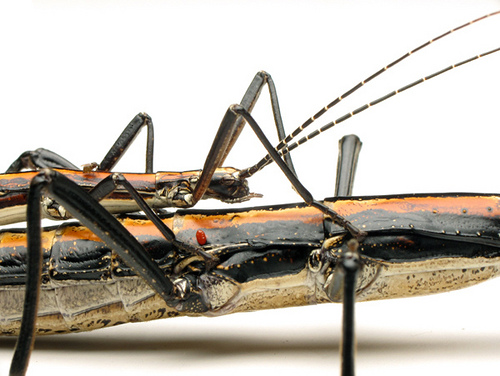Chemical Defense
Anisomorpha
buprestoides is most commonly known for its unique chemical
defensive spray that it produces to ward off predators.
This irritating and odiferous substance is a milky-white, acidic chemical
that is secreted as a defensive response from its
prothoracic glands (Conle et al.
2009). Its main components include varying combinations of
three different
diastereomers: anisomorphal, dolichodial, and peruphasmal
(Dossey 2008). The fluid is created and held in long
compartments inside the thorax (Eisner 1965), while it is
released from
notches just behind the head at an anterolateral angle
(Littig 1942). Even in its nymph stage,
A. buprestoides’ glands
are fully functional and can successfully repel an ant
attack (Sondheimer 1970).

When sprayed, the substance is extremely foul smelling and can cause intense
but only
temporary irritation in its victim’s eyes and soft tissues
(Sondheimer 1970). In some cases, short-term
blindness has been reported (Sondheimer 1970). The two-striped
walking stick will always shoot its venom when triggered by a
stimulus resembling a predator (Sondheimer 1970). The
attacker does not have make contact with the
walking stick, but merely approach it threateningly to initiate
this reaction. The
discharge can be an effective defense against predators such as
ants,
beetles,
birds, and
mice (Sondheimer 1970). That does not mean humans are
immune; take caution if approaching one of these bugs. The
two-striped walking stick has sprayed plenty of humans that came
too close. Keep your pets safe too, because dogs have been
a frequent victim of these attacks as well. In fact,
A. buprestoides can accurately
hit an attacker's eyes within a 30 to 40 centimeter range
(Eisner 1965; Sondheimer 1970). Then, once the compartments of the
chemical substance has been depleted, it can
take one to two
weeks to completely restock the fluid (Eisner 1965).
Just as in many other aspects of the two-striped walking stick's behavior, the three different color forms exhibit signficant differences with their chemical defense too. The white, orange, and brown forms live in varying habitats and thus eat different forms of fauna, which affects the chemical compositions of their secretion (Conle et al. 2009). Therefore, we see different combinations of the three diastereomers present among the color forms. In addition, the composition also depends on their developmental stage; nymphs generally produce a different combination of diastereomers than the mature adult does (Dossey 2008). Furthermore, the three color forms behave differently when threatened by an animal. After they release their chemical defense spray, the brown form of A. buprestoides will stay still until the threat is gone, while the white and orange forms will walk away quickly or drop to the ground if perched on a plant (Conle et al. 2009).
←Form and Function Home Reproduction→